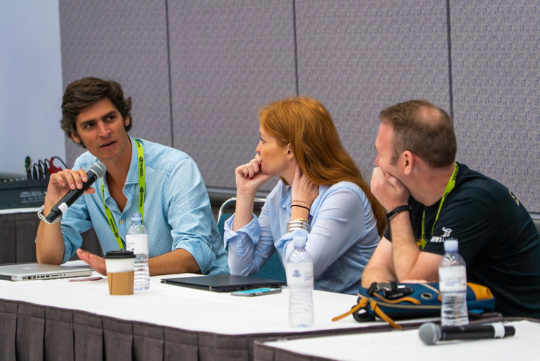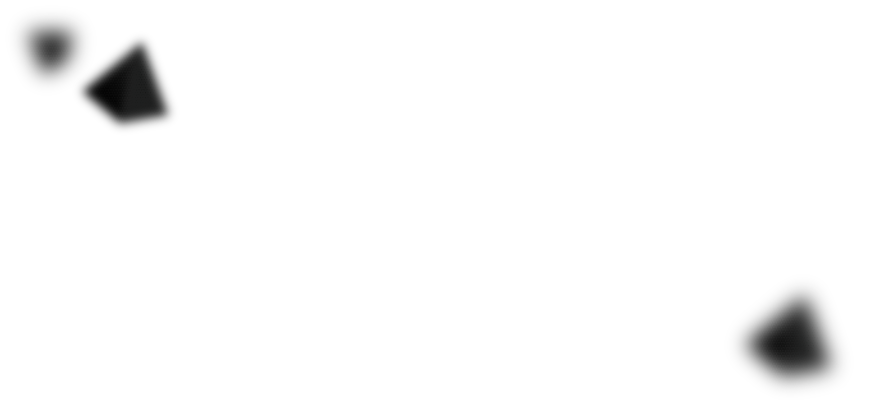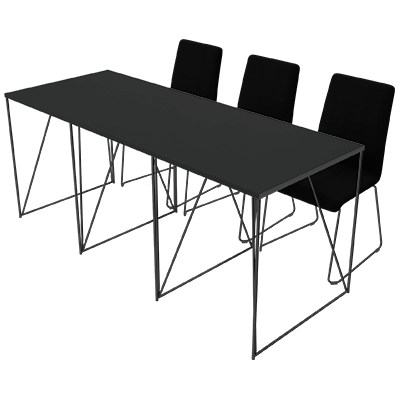Discuss New Perspectives
Panels
Lively discussion among leading experts in computer graphics and interactive techniques presents diverse perspectives for consideration and inspiration.




“The Panels program at SIGGRAPH 2021 is a great way for attendees to hear from key industry figures as they engage in conversations about some of the most important topics in the industry. This year, you can expect to hear about diversity, esports, live VR performance, and design for feature animation. I am eager to hear more about all of these subjects at this year’s conference!”
Chris Redmann
SIGGRAPH 2021 General Submissions Chair
How to Submit
SIGGRAPH 2021 will move forward at this time as a virtual-only event. We look forward to celebrating 48 years of advancements in computer graphics and interactive techniques in our virtual venue. We are excited you are submitting your work for consideration. As we finalize our conference plans, visit the About the Conference page for the latest updates.
Log into the submission portal, select “Make a New Submission” tab, and select “Panel.” To see the information you need to submit, view the Sample Submission Form.
For more information about uploading files for your submission, please see Uploading Files.
Evaluation
Panels are forums for experts in a particular area to have a guided, interactive dialogue with the audience about a specific topic. A good Panels submission proposes an interesting topic, identifies panelists who will bring diverse opinions to the discussion, and outlines a proposed structure for the panel discussion itself. Good Panels do not rely on slides or lots of prepared materials.
Examples of accepted content from past conferences, including Panels, have been made freely available by the ACM SIGGRAPH organization and can be accessed here.
Some reasons Panels proposals are rejected:
- The panel organizer has not confirmed specific speakers or has identified speakers but not clearly conveyed why those speakers are the best ones to address the proposed topic.
- The proposed panel topic is of very narrow interest and will only appeal to a very small number of attendees.
- The proposed panel topic is too broad or not defined well enough to engender a focused discussion.
- The proposed panel lacks structure, or the structure fails to allow significant audience interaction. A panel that consists primarily of prepared statements by the panelists will be rejected.
- The jury believes the panelists do not offer sufficiently diverse viewpoints.
Jurors are asked to evaluate your submission using four criteria: concept, novelty, interest, and quality. The final submission score is based on a combination of these factors. For example, a high-quality panel that has broad appeal and is unlike other recent SIGGRAPH Panels has a good chance of acceptance, while a poorly motivated submission of interest to few attendees (or that duplicates recent panels) probably will be rejected.
Concept
How exceptional are the ideas, problems, solutions, aesthetics, etc., presented in this submission? How coherently does the submission convey its overall concept? Is the concept similar to existing ones, or does it stand out? This criterion is particularly applicable to submissions that put together existing technologies into a single product (for example, demos, animations, art pieces). Submissions of this type, where the individual technologies are not necessarily new but their combination is, are evaluated on both the final product and how well proposed technologies integrate to meet the desired goals. Many submissions in this area are rejected because they do what existing systems do, and they do not demonstrate that the proposed approach leads to better results.
Novelty
How new and fresh is this work? Is it a new, ground-breaking approach to an old problem, or is it an existing approach with a slightly new twist? You must first demonstrate to the jury that your work is sufficiently different from existing approaches. Second, you should evaluate your work in the context of other approaches where appropriate: Is it faster? Easier to use? Does it give better results? Is it more accurate? Many submissions are rejected either because the work is too similar to existing work or because the submission materials did not convince the jury that the improvements were substantial enough.
Interest
Will conference attendees want to see this? Will it inspire them? Are the results or approach appealing to a broad audience? This is partly a measure of how broad the potential audience is and partly a measure of the overall clarity and novelty of the submission. A submission in a very niche area is more likely to be accepted if the results are exceptionally better than what exists already or if the proposed solution might be applicable to other areas.
Quality, Craft, and Completeness
This is a measure of how well written the abstract is and the quality of the supporting materials. The abstract must effectively communicate both the problem and the solution in enough detail and clarity that the jury can evaluate it. You also must convince the jury that your solution works. Many submissions are rejected because, although the problem and solution seemed interesting, the materials did not convince the jury that the solution actually had been implemented and evaluated. If your submission has an animation, simulation, or interactive component, including a video is essential.
Upon Acceptance
If your panel is accepted, you must prepare and submit a revised abstract (two pages maximum). The two-page abstract should include an overview of the topics being discussed and brief biographies of each participant.
You will be notified of acceptance or rejection of your panel at the end of April 2021 and receive an email from “rightsreview@acm.org” with information about and a link to your work’s rights form within 72 hours of notification of acceptance of your work to the conference. When your rights form has been delivered to ACM, you will then receive an email from “tapsadmin@aptaracorp.awsapps.com” with information about the preparation and delivery of your material to TAPS for publication.
Please make sure that emails from “rightsreview@acm.org” and “tapsadmin@aptaracorp.awsapps.com” are part of the “allow list” in your email program, so that you do not miss these email messages.
The source (Word or LaTeX) of your abstract, as well as any supplemental materials, must be delivered to TAPS, ACM’s new article production system. TAPS will generate the PDF and HTML5 versions of your abstract for publication in the ACM Digital Library.
You must deliver your material to TAPS, resolve any formatting issues identified by TAPS or by the proceedings production editor, and approve your material for publication by 28 May 2021. If you cannot meet that deadline, you will not be allowed to present your material at SIGGRAPH 2021.
Information about the preparation and delivery of your final material to TAPS can also be found at https://homes.cs.washington.edu/~spencer/taps/taps.html.
After acceptance, the submission portal will allow you to update basic information about your work and upload any final materials for inclusion in the conference program and website. You will receive information on how to submit final versions of your accepted work and the deadlines for final updates.
You will be responsible for managing your moderator (if it’s not you) and panelists. This includes coordinating with conference organizers to prepare the panel description and speaker information for publication on the website and in conference materials. It also requires that you distribute registration discount codes to your panelists and that you check in with them during the conference.
Please note: Panels are about people and discussion, not presentations. Panels should not rely on PowerPoint slides, video clips, or other visual materials.
Presentation
To present in the virtual conference, the Panels contributor must provide a video of their presentation or present live. Final recordings of the Panel will be published in the ACM Digital Library. Further details and instructions regarding the video specs (if applicable) will be provided upon acceptance.
Presenter Recognition
To present your work at SIGGRAPH 2021, at least one contributor per submission must register at the appropriate registration level. All other contributors can register at the level of their choice.
You can find a link to the contributor recognition policy here.
ACM Rights Management Form
If your work is accepted for presentation at SIGGRAPH 2021, you must complete the ACM Rights Management Form. The form will be sent to all submitters whose work is accepted.
Your representative image and text may be used for promotional purposes. Several SIGGRAPH 2021 programs — Art Gallery, Art Papers, Real-Time Live!, Technical Papers, and all installation programs — will prepare preview videos for pre-conference promotion of accepted content, which may include a portion of the video you submitted for review. You may grant or deny us the ability to use the representative image and submitted video for these purposes.
Timeline
23 February 2021, 22:00 UTC/GMT
Submission form deadline
End of April 2021
Acceptance or rejection notices are sent to all submitters.
10 May 2021
Deadline to make any changes to materials (i.e., approved title changes, presenter names, descriptions) for publication on the website.
28 May 2021
Two-page abstract due. If we do not receive your revised abstract by 28 May, you will not be allowed to participate in SIGGRAPH 2021.
Summer 2021
SIGGRAPH 2021

